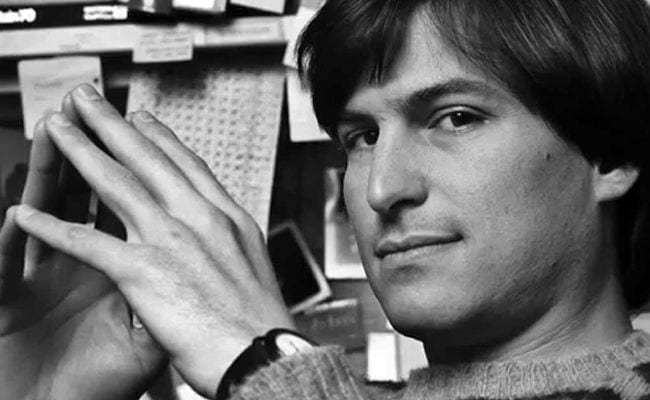
“I was one of those people who had to have an iPhone. I didn’t want to hear about other products and I believed against all reason that owning an iPhone made me part of something better. And when it was in my pocket, for every idle moment, my hand was drawn to it, like Frodo’s hand to the ring.” As Alex Gibney speaks, you see a series of images at once familiar and strange. Customers stand in line outside an Apple store, bent over the devices they currently own.
The shot cuts to a view of the store, the Apple icon perfect and white. You look in from outside, through glass that reflects and also blurs New York City traffic, as customers stand at tables, bent over devices they will own.
It may be, as Gibney suggests, that possessing an iPhone, touching and knowing it, shapes a sense of a particular sort of identity, a sense of belonging to “something better”. It may also be, as Gibney’s Steve Jobs: The Man in the Machine posits, that your belief in such identity has multiple causes and contexts, including a brilliant, pervasive commercial campaign.
Thinking through the connections between the product’s campaign and design, the film finds a particularly mesmerizing focus in Jobs, as he appears in all manner of footage, from personal archives and TV, promotional images and depositions. GIbney describes his starting point; that is, bearing witness to the overwhelming public grief over Jobs’ death. A TV screen confirms the process: “It’s not often that the whole planet seems to feel a loss together,” observes Diane Sawyer on ABC News the night Jobs died, noting that this “singular dreamer” inspired a “kind of global wake” — performed on social media, of course. The film underlines the ritual by playing Bob Dylan’s “Mr. Tambourine Man” on the soundtrack, a gesture simultaneously celebratory and ironic.
As it investigates this simultaneity, the movie contemplates how Jobs and Apple continue to transform the “whole planet”. Canny and provocative, Gibney’s own self-reflection is key to this mediation, as it is in his previous films, from Taxi to the Dark Side to Catching Hell to Going Clear. His thinking out loud doesn’t impose an order on what you see as much as it adds layers and poses questions. If GIbney’s questions are not precisely yours, his premise — that documentaries must ask questions rather than presume answers — is bracing, reimagining not only what documentaries can do, but also what belief can do.
In this context, Jobs is an ideal object for study. “I think jobs was always a storyteller,” notes tech journalist Michael S. Malone. Inspired and revered, he could also be, as the film recalls, “behind the scenes… ruthless, deceitful, and cruel.” Recounting instances that are both infamous and less known (his abuse of Apple cofounder Steve Wozniak, his initial rejection of his daughter Lisa, his chilling disregard for Chinese factory workers’ health), the film suggests that, rather than seeing Jobs as a kind of split personality, an hero and a villain, you might better understand the connections among his seemingly contradictory behaviors, his astounding aspiration and confounding myopia, his spectacularly staged new product announcements and his “highly developed tax avoidance system”.
The film’s structure, gliding between Jobs’ life story and his legacy, helps you see how the devices embody both. The iPhone is built on competing fictions of intimacy and anonymity, preservation and impermanence. Elegant and thrilling, this bit of reproducible art is outrageously profitable, sold as a status symbol, and of conformity and individuality at the same time. The camera underlines the device’s sleek surfaces, lingering on the product, as if selling it. You become aware that each step in this process, investigative and contemplative, repeats the pitch, that the company not only has value but also, as Jobs said more than once, values.
Even early on, the product, Sherry Turkle observes, inspired devotion. With the iMac, she says, Jobs “was going for a computer that really felt like an extension of the self.” The iPhone seems a realization of that dream, especially in the effects it creates. “I remember the first set of people I interviewed about the iPhone,” Turkle remembers, “I’ve never seen this sort of connection before with an object.” Joe Nocera offers a more succinct judgment: “A phone is not a mythical device. It sort of makes you wonder less about Apple than about us.”
The film, too, wonders about us. It questions Jobs’ iconography, his self-promotion, his mythology — all which are intertwined with his company in compelling and vexing ways. (Or, his company, then not his company, then his company again). From its start, Steve Jobs: The Man and the Machine turns its questions back from the man and the machine to you. As GIbney leaves behind the man and looks instead at that “fleeting moment before I press the home key and the screen lights up,” he sees and shows that it’s “asking me what, in buying and using this product, I am doing.”


![Call for Papers: All Things Reconsidered [MUSIC] May-August 2024](https://www.popmatters.com/wp-content/uploads/2024/04/all-things-reconsidered-call-music-may-2024-720x380.jpg)



